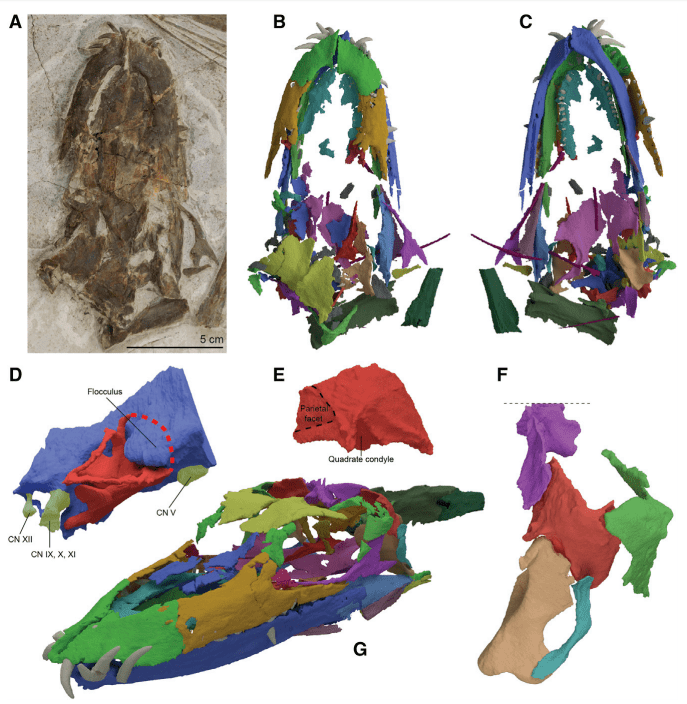Researchers have finally made sense of a dinosaur first described in 1852. Called Tanystropheus, the dinosaur’s anatomy made it unclear whether it lived in the sea, or on land.

Image credits Stephan Spiekman et al., (2020), Current Biology.
Now, computer tomography (CT) scans of the fossil reveals that the animal was indeed an ocean-dweller, according to the Fields Museum. More interestingly, it seems that the fossils they have found belong to not one but two very similar species, who nevertheless grew to vastly different sizes. They also likely hunted different prey and lived side-by-side.
Long-necked
“I’ve been studying Tanystropheus for over thirty years, so it’s extremely satisfying to see these creatures demystified,” says Olivier Rieppel, a paleontologist at the Field Museum in Chicago and one of the authors of a new paper detailing the discovery.
Because of its hollow bones and very long necks (which were initially mistaken for wings), Tanystropheus was first believed to have been a flying species, similar to a pterodactyl. Later on, we figured out that this 6-meter-long (20ft) animal actually had a 3-meter-long (10ft) neck.
Its weird proportions — the animal’s neck was three times as long as its torso — made it unclear as to where it lived. By scanning the crushed Tanystropheus skull and digitally reassembling the pieces, however, the team found it was very likely water-dwelling. The skull had telltale signs, including nostrils on top of the snouts (like a crocodile). Due to such features, it probably ambushed its prey, relying on long, curved teeth to keep them from escaping.
While it is possible that Tanystropheus came to land to lay eggs, it was overall a marine animal.
The species lived around 242 million years ago during the middle Triassic. Dinosaurs had just started to emerge on land, and Tanystropheus‘ strange body proportions certainly match such strange times. It was found in today’s Switzerland.
“Tanystropheus looked like a stubby crocodile with a very, very long neck,” says Rieppel.
The larger specimens were twenty feet long, with their necks making up ten feet of that length. Oddly for animals with such long necks, they only had thirteen neck vertebrae, just really elongated. (We see the same thing with giraffes, which have only seven neck bones, just like humans.) And their necks were rather inflexible, reinforced with extra bones called cervical ribs.
Smaller cousin
Smaller but strikingly similarly fossils were found in the same region as many of the big Tanystropheus fossils, which initially confounded researchers. These animals only grew to around 1 meter (4 ft) in length. The team’s analysis revealed that bones from both the large and small dinosaurs had large numbers of growth rings, suggesting that both were adults, despite their size.
“For many years now we have had our suspicions that there were two species of Tanystropheus, but until we were able to CT scan the larger specimens we had no definitive evidence. Now we do,” says Nick Fraser, Keeper of Natural Sciences at National Museums Scotland and a co-author of the paper.
“It is hugely significant to discover that there were two quite separate species of this bizarrely long-necked reptile who swam and lived alongside each other in the coastal waters of the great sea of Tethys approximately 240 million years ago.”
Their different size, and different teeth — cone-shaped teeth in the big species and crown-shaped teeth in the little species — points to them having different diets, so they were probably not competing for the same resources (a process called niche partitioning).
“These two closely related species had evolved to use different food sources in the same environment,” says Spiekman. “The small species likely fed on small shelled animals, like shrimp, in contrast to the fish and squid the large species ate.”
“This is really remarkable, because we expected the bizarre neck of Tanystropheus to be specialized for a single task, like the neck of a giraffe. But actually, it allowed for several lifestyles. This completely changes the way we look at this animal.”
While competition steals the limelight in discussions around evolution, processes like niche partitioning shows that species can live side-by-side, perhaps even cooperate. An important element that allowed for this to happen is likely that the Tethys Ocean was huge, so there were enough resources to go around for both species.
The paper “Aquatic Habits and Niche Partitioning in the Extraordinarily Long-Necked Triassic Reptile Tanystropheus” has been published in the journal Current Biology.









